Formative Assessments
The below formative assessments allowed me to see how well my student’s felt about a certain concept, and guide my teaching from the information I gathered.
#1: Self-Assessment: Reader’s Theatre
After learning what volume, pace, and tone are, I allowed students to practice fluctuating these with a reader’s theatre activity that connected to our short-story unit (theme was about honesty). Prior to each groups performance, they knew they would be assessed on their volume, pace, and tone. After the performance, students filled in the following self-assessment:
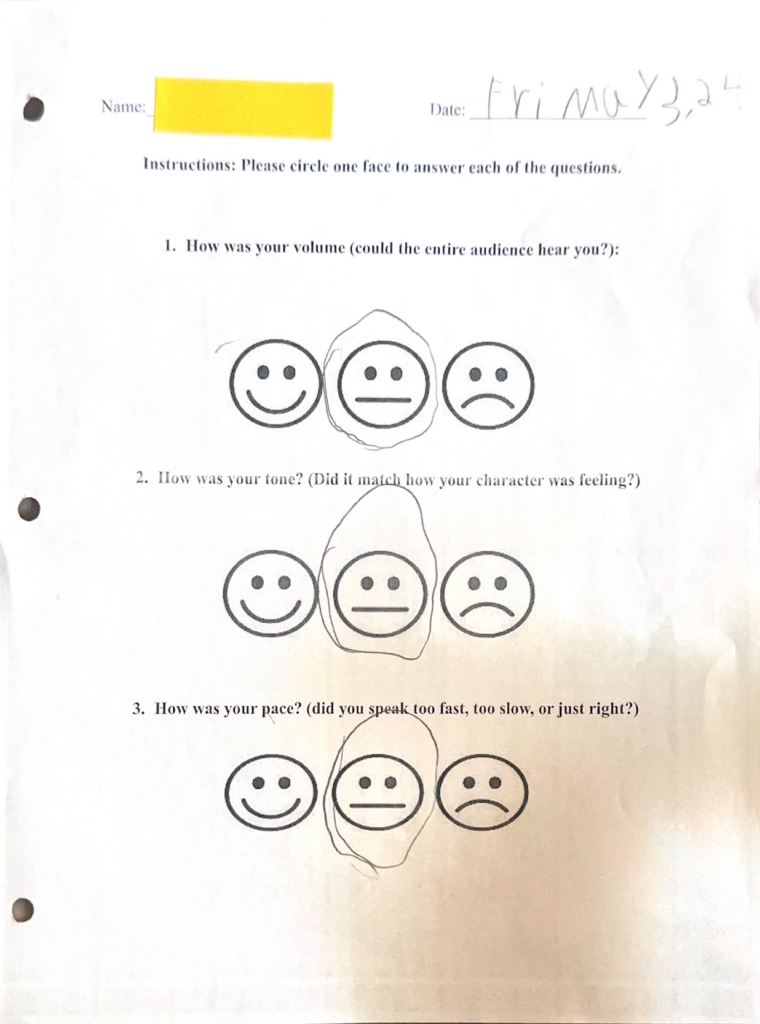
#2: Self-Assessment: Watercolour Painting
First I taught students watercolour painting techniques and then provided the project criteria on an anchor chart. I converted the criteria on the anchor chart into a self-assessment for the students to check and see if they met the criteria. I really loved this because students who had a bock unchecked were able to go back and revise their work to make it the best they could be! Students said “I liked it because I knew if I was missing something and could fix it myself”- Student. I took time to review students self-assessments and compare them to the artwork the handed in and the majority were exactly how I would have assessed their learning as well. Below is an example:
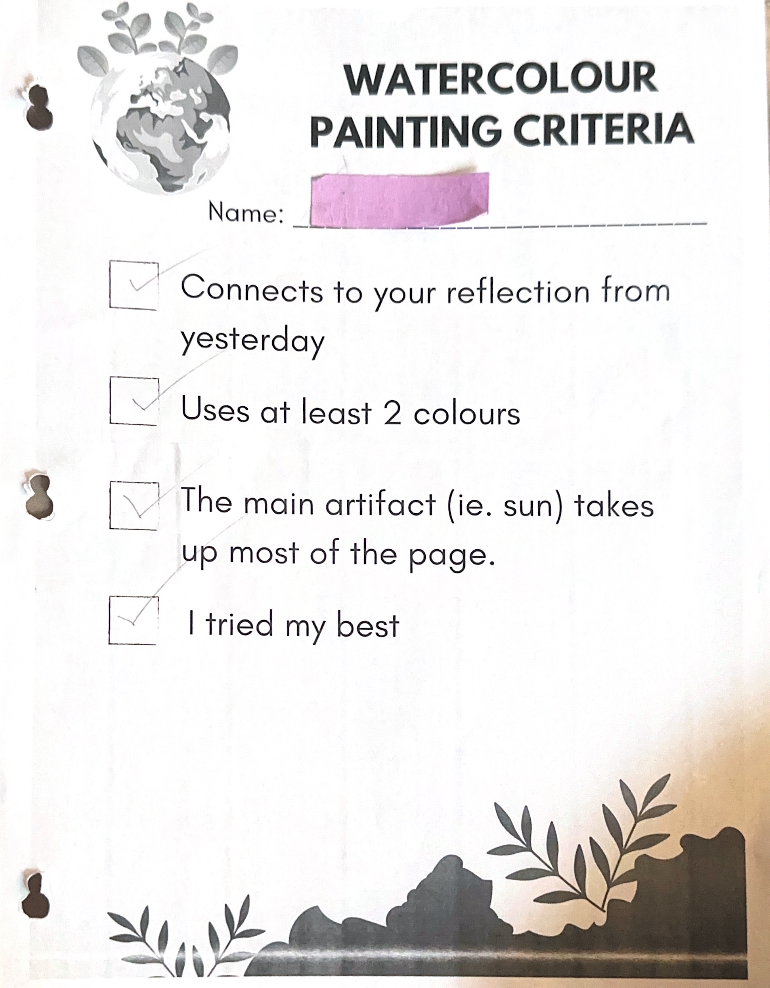
#3: Self Assessment: Oil Pastel Artwork
Due to the success of the above assessment, I chose to do the same thing for our oil pastel artwork. See example below:
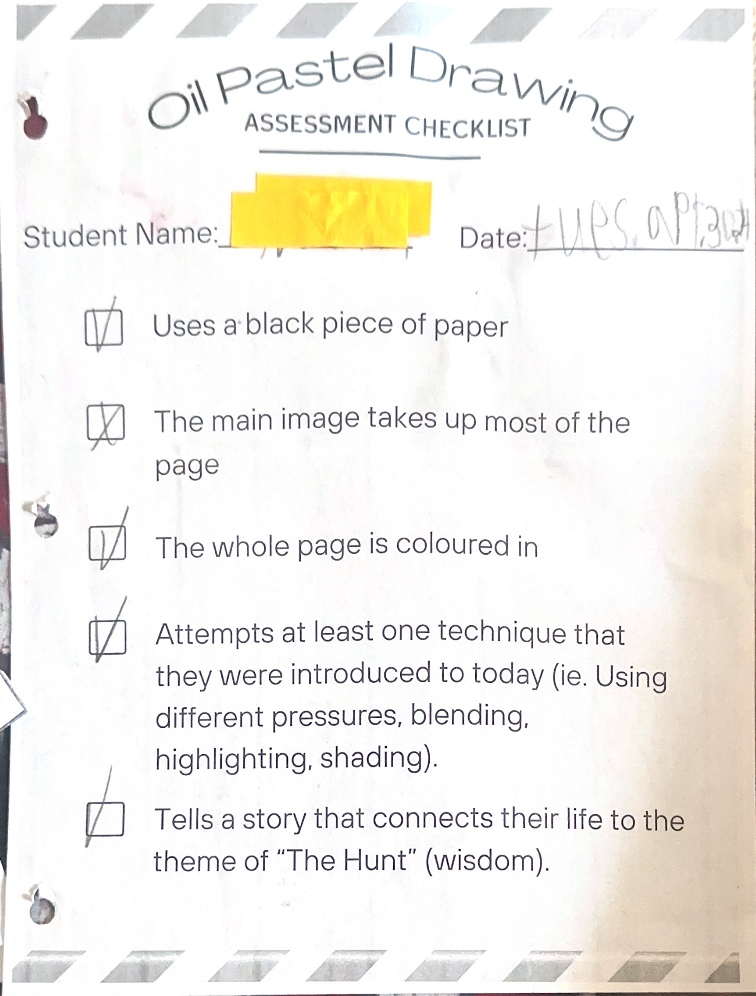
#4: Worksheets: What’s the Area?
For a few lessons I found it useful to use worksheets to assess students learning. For example, I took the information from the below worksheet and thought to myself that it is evident they understand the concept of finding area of a rectangle in pictorial form, and we can move on to finding the area of rectangles symbolically (ie. 5cm x 6cm). There were three students who I noticed required further explanation of the concept. This may have been a reflection of my own teaching that I needed to explain it in a different way. I chose to pull these students aside in downtime and explain the concept using concrete blocks. After doing this a few times then applying it to the worksheet, it was evident the students understood the concept. In the future, I would start with explaining the concept concretely before jumping to the pictorial stage. Below is an example of the worksheet:

A second example of a worksheet I created was a table that allowed students to compare the heaviness or lightness of an object as a way to introduce the mathematical concept of mass. What I loved about the table worksheet is that students were creative in the different objects they chose to compare, so I saw a wide variety of “answers”. I also loved that they had to use communication and collaboration skills to complete this worksheet with a small group. Example is below:
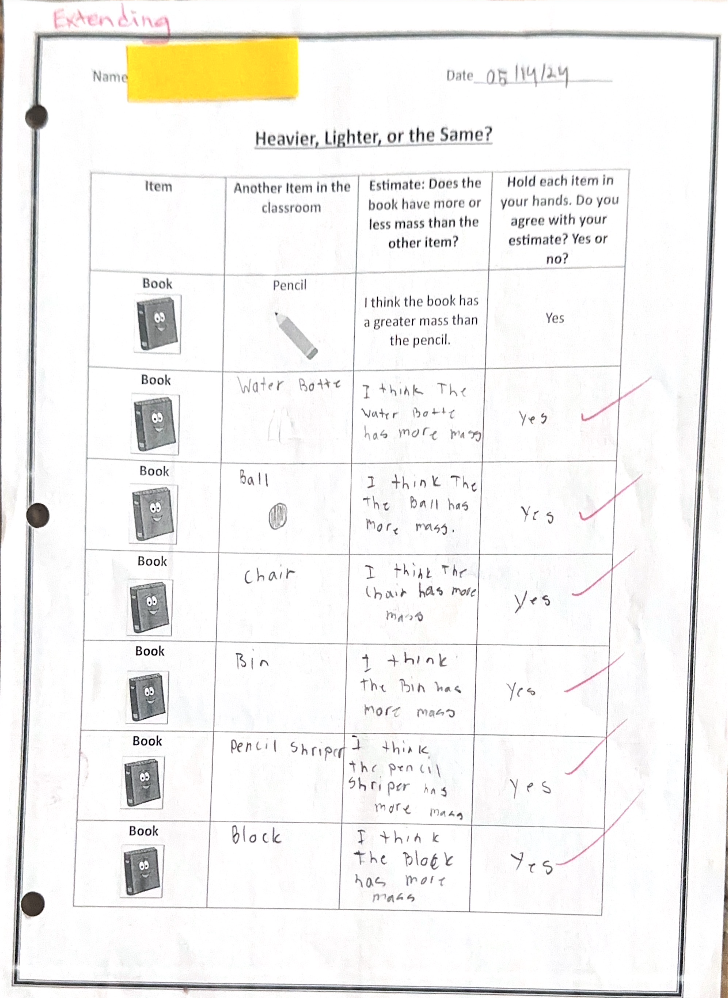
#5: 2-1-1 Reflection: Learning to Make Bannock
As I was planning my lesson to teach students how to make bannock, I began thinking about the First Peoples’ Principles of Learning. One of them explains that “Learning is holistic, reflexive, reflective, experiential, and relational” (FPPL, 2024). Weaving this into my lesson, I chose to make the formative assessment a reflection. I learned a lot about students thinking and noticed some questions that were not answered and took this as an opportunity to answer them the following day. I also noticed that students understood the meaning of the concept of capacity in our math measurement unit, and we could move onto learning about mass. Please see the below student example:
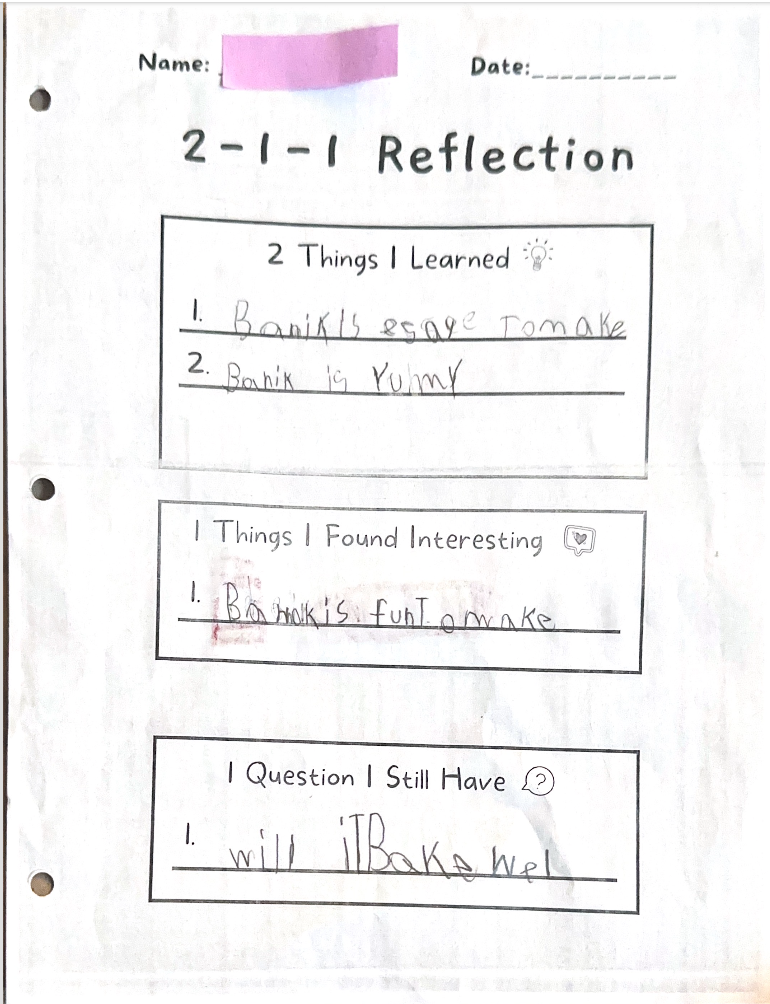

#6: Peer-Assessment: Thank You Cards
Prior to making the bannock, I had the students create thank you cards as a gift of reciprocity to Michelle Whalstrom our Indigenous Education Worker who came to help us make bannock. Prior to making the cards I modelled an example and compared it to the criteria. I then turned the criteria into a peer- assessment. First students had to have a peer assess their card and revise anything not checked. Once revised, students came to check in with me to have it signed off as complete. This ensured accountability from the students to create the best thank you cards possible. Example of the peer-assessment checklist is below:
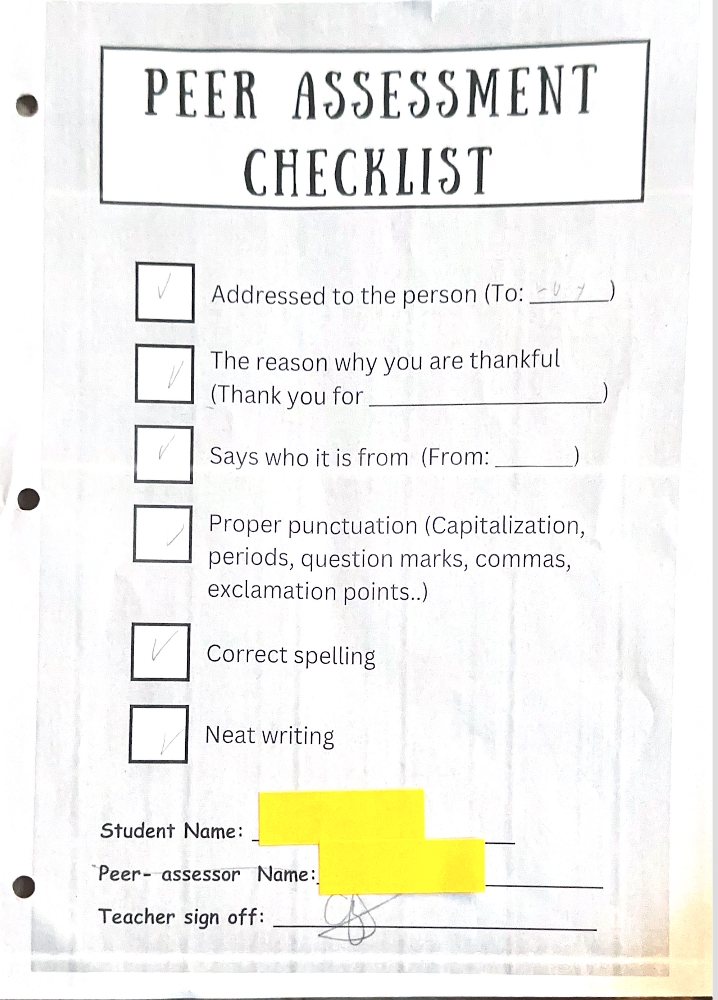
#7: Self-Assessment Checklist: Land Acknowledgment
I started my unit on “Turtle Island Voices” with my own land acknowledgment and then had students create their own as a respectful way to start the unit that was based around books written by Indigenous authors. Below is an example of a student’s self-assessment checklist they completed before handing in their good copy.
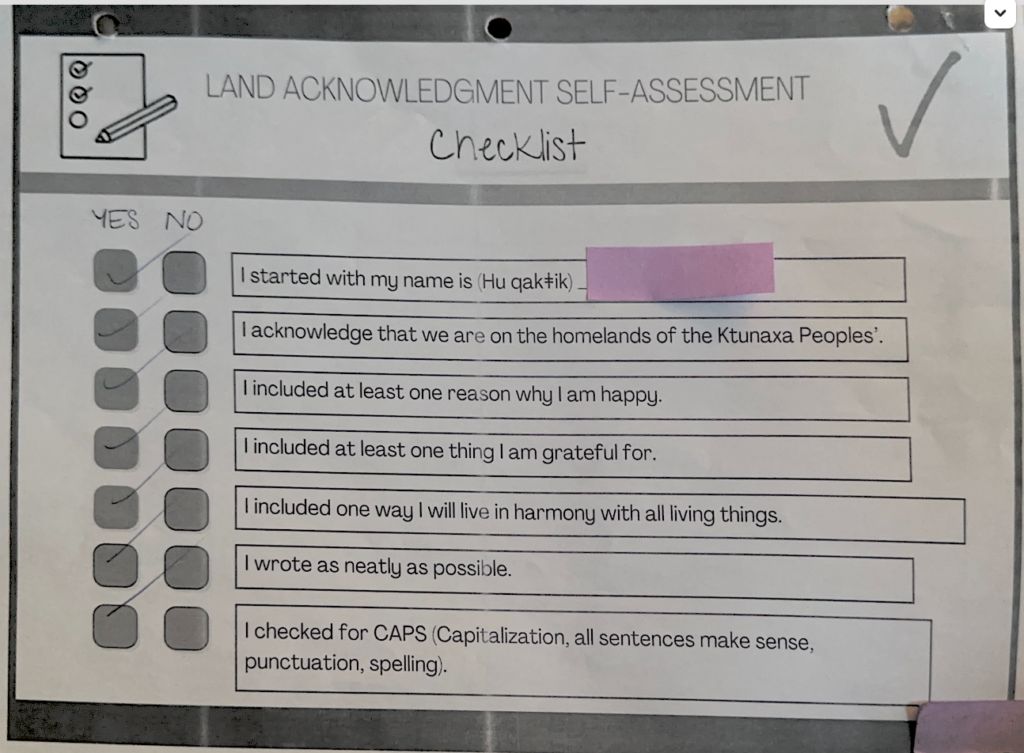
#8: Group Self-Assessment: Creating Chalk Animals
This was one of my student’s favourite activities over the course of my practicum! After teaching students how to use the standard measurements centimetres, and metres, in small groups I had them create their own, never-discovered before animals! They were required to be creative while still following the outlined criteria. See the below assessment the groups used. I went around and measured each group’s animal’s eyes, legs, and feet to see if they met the criteria. If they did not, I supported them by modelling and having them demonstrate back how to make those measurements. See the below examples:
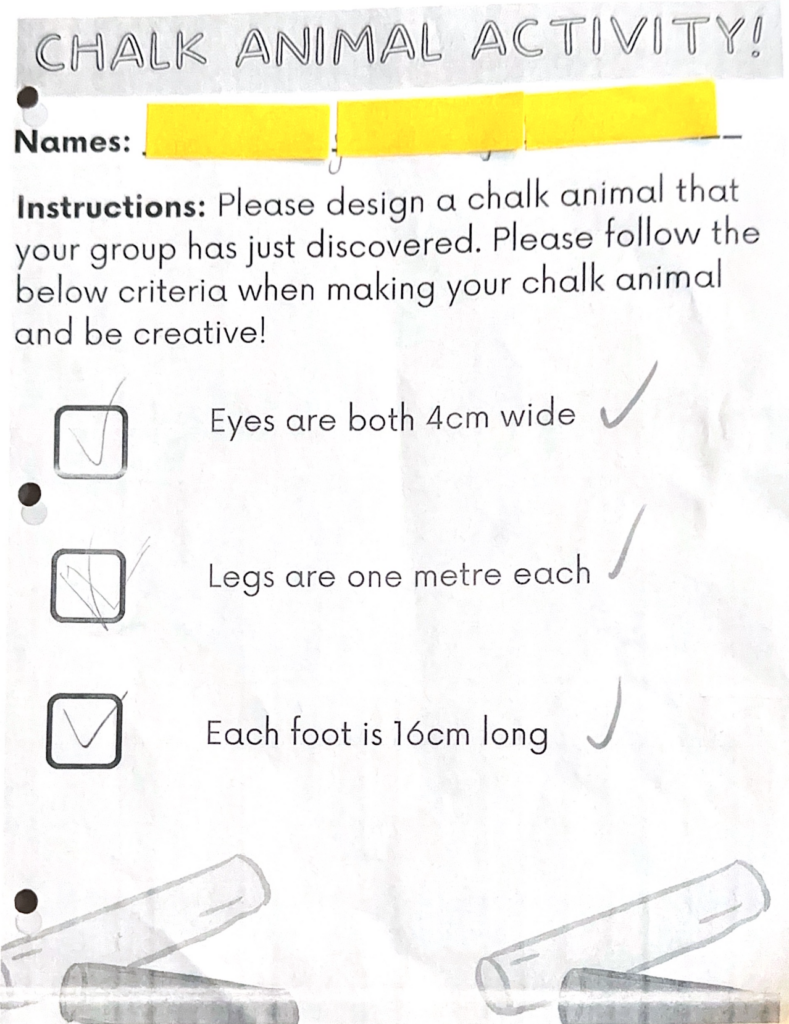
#9: Exit Ticket: What Is the Best Measurement?
After teaching students the different types of linear measurement in our metric system (cm, M, Km), I provided a formative assessment to see their understanding of the best measurement for a specific situation. This gave me insight into their understanding of applying the concept to the real-world. Pease see the below example:
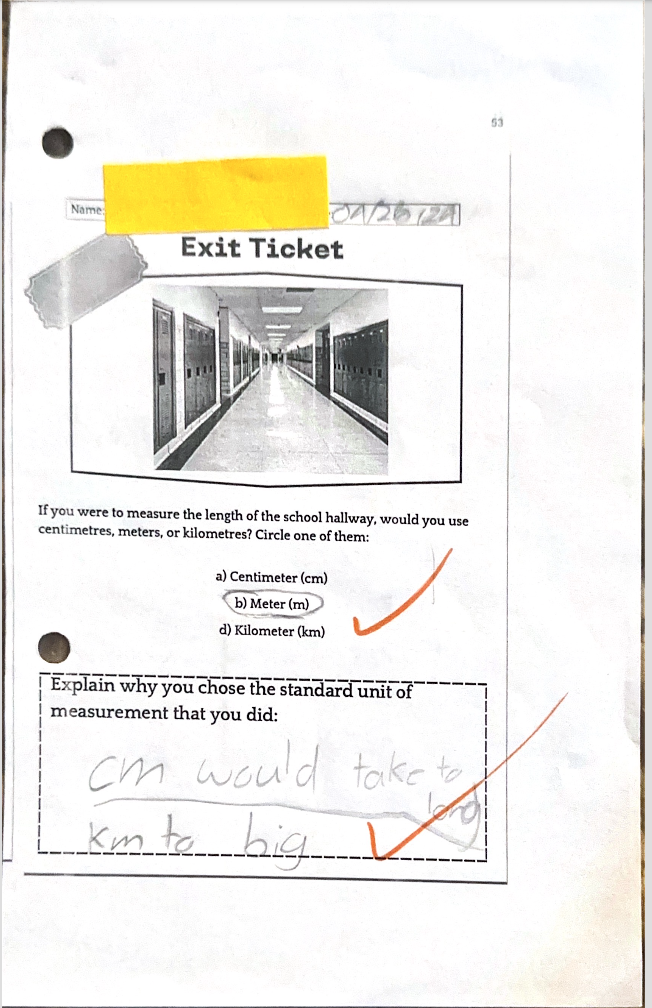
#10: Other Successful Formative Assessment Strategies
I do not have images of the following but I would absolutely use these strategies in the future:
- Agree/disagree circles.
- Choose 1 question to answer (I would put three on the board).
- Roll and reflect.
- Vertical Whiteboards.
- Four Corners.
- 2 Truths and 1 Lie.
- Quick Draw.
- Graffiti Wall.
- Individual Whiteboards.
- Relay’s.
Summative Assessments
I used the below summative assessments to check individual students’ understanding of unit concepts in relation to curricular outcomes (competencies, content, core comps).
#1: Single Point Rubric: Boomwhacker Unit
I learned about the single point rubric from our science teacher Judi Poole and found more information from this website: Cultofpedagogy.com. Below is an example of how I adapted it to work for my boomwhacker music unit. I would absolutely use this form of summative assessment again (easy to follow, personable, and relates well to the BC proficiency scale).
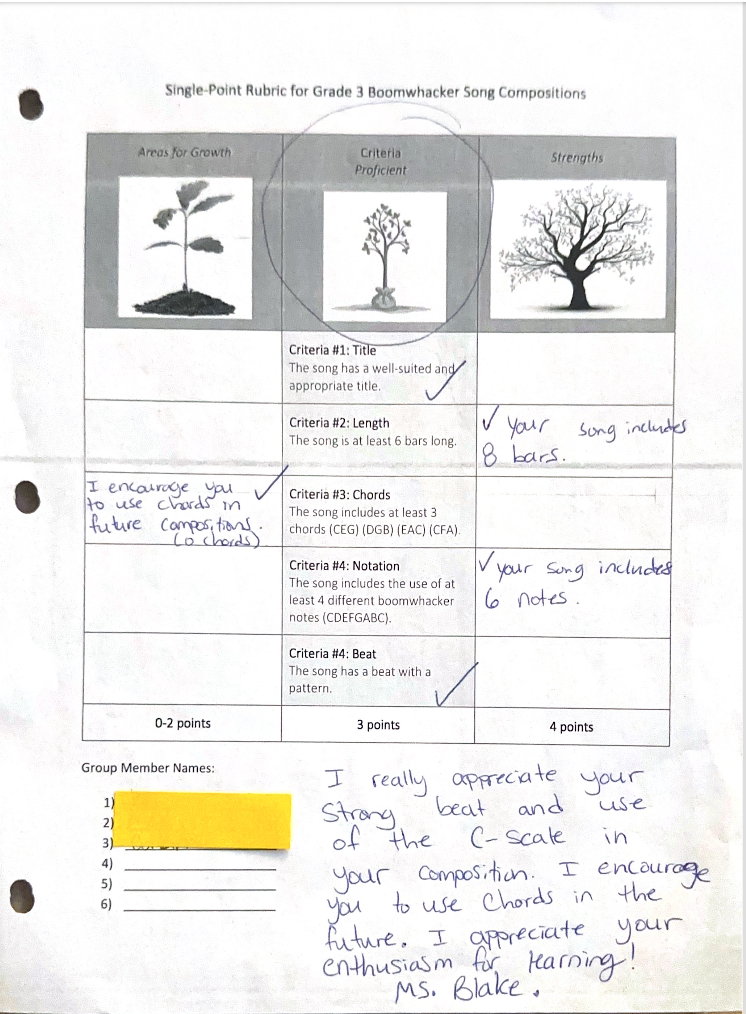
#2: Co-Create Rubric: Story Vines
My assessment Instructor, Catherine Phyllis, opened my eyes to co-creating rubrics with students. I found that this increased student engagement and accountability for their final projects (story vines). To create a rubric as a class, we followed the 4 critical steps explained in the book “Making Classroom Assessment Work” by Anne Davies.
Step #1: Brainstorm a list of ideas: What is important for a quality story vine and re-telling of a story?
Step #2: Sort and group the ideas: Star the main points and dash the sub points.
Step #3: Make and post a T-chart
Step #4: Use and revise as students learn more.
After completing the above steps, I took the student’s input and created a rubric that had 4 points under each assessment criteria so that it aligned with the BC Proficiency scale. The finished rubric example is below:
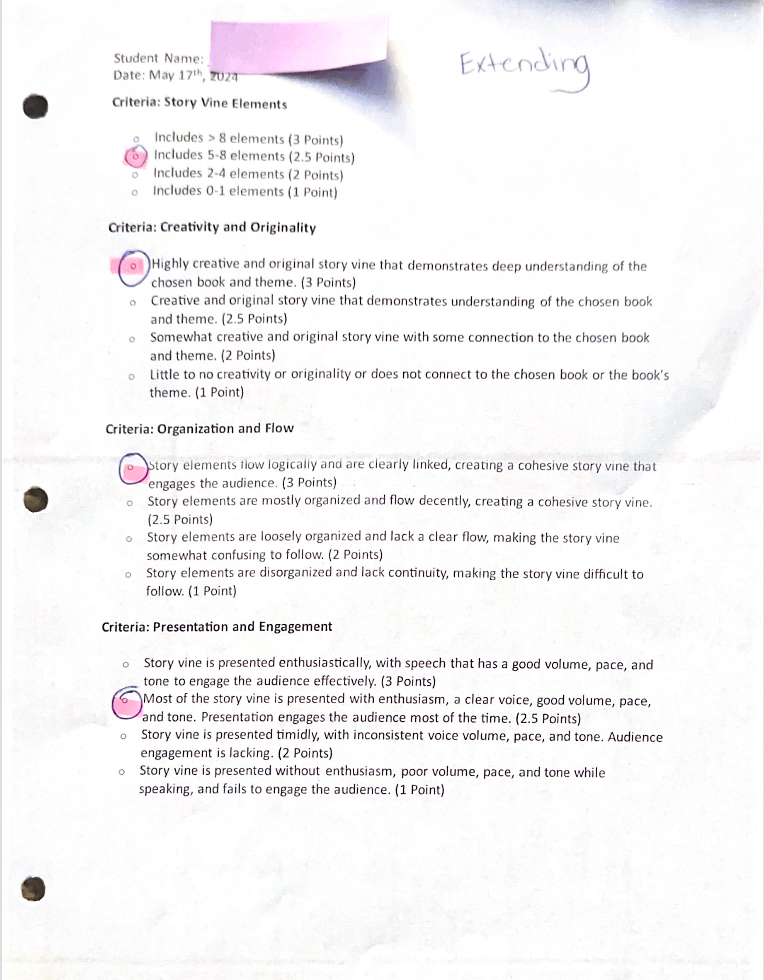
#3: Jeopardy: Math Measurement Unit
After collaborating with my mentor teacher, I chose to do a class game of jeopardy as a celebration of learning and summative assessment for our math measurement unit! It was an absolute blast for the students and I!
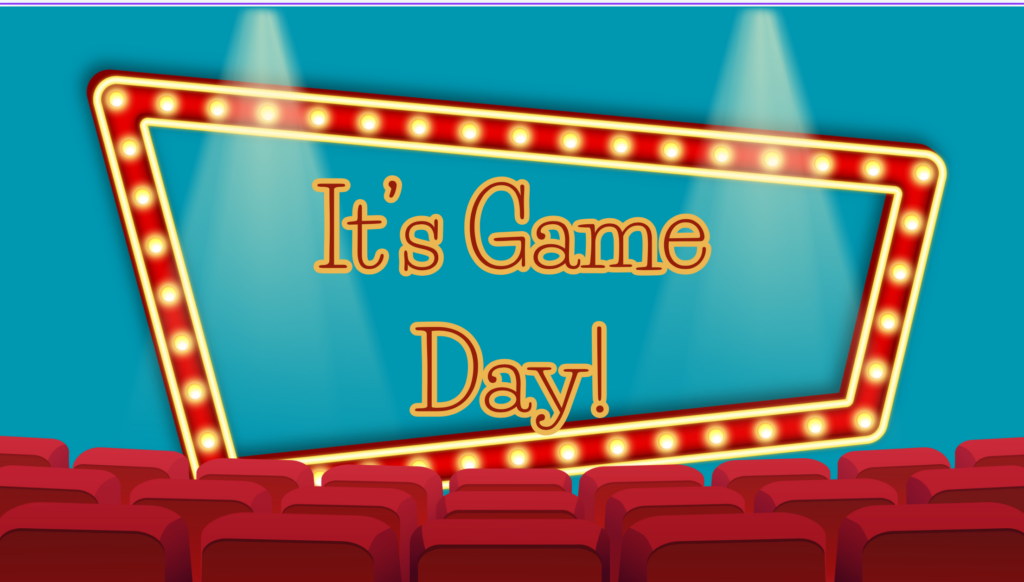
First I created an online Jeopardy game based on all of the learning we did about measurement using the website Jeopardy labs. I also created a Canva presentation explaining the rules and expectations of the game. Below are the links to both:
- Jeopardy Game (Grade 3 measurement): https://jeopardylabs.com/play/measurement-jeopardy-395
- Canva Presentation (Grade 3 measurement): https://www.canva.com/design/DAGAXvfPL5I/MbMvAZpZhRtKlnKhMKzEJg/edit?utm_content=DAGAXvfPL5I&utm_campaign=designshare&utm_medium=link2&utm_source=sharebutton
Self-Assessment of Core Competencies
Below is an example of how I created a student self-assessment of the Core Competencies to conclude our music unit (boomwhackers):
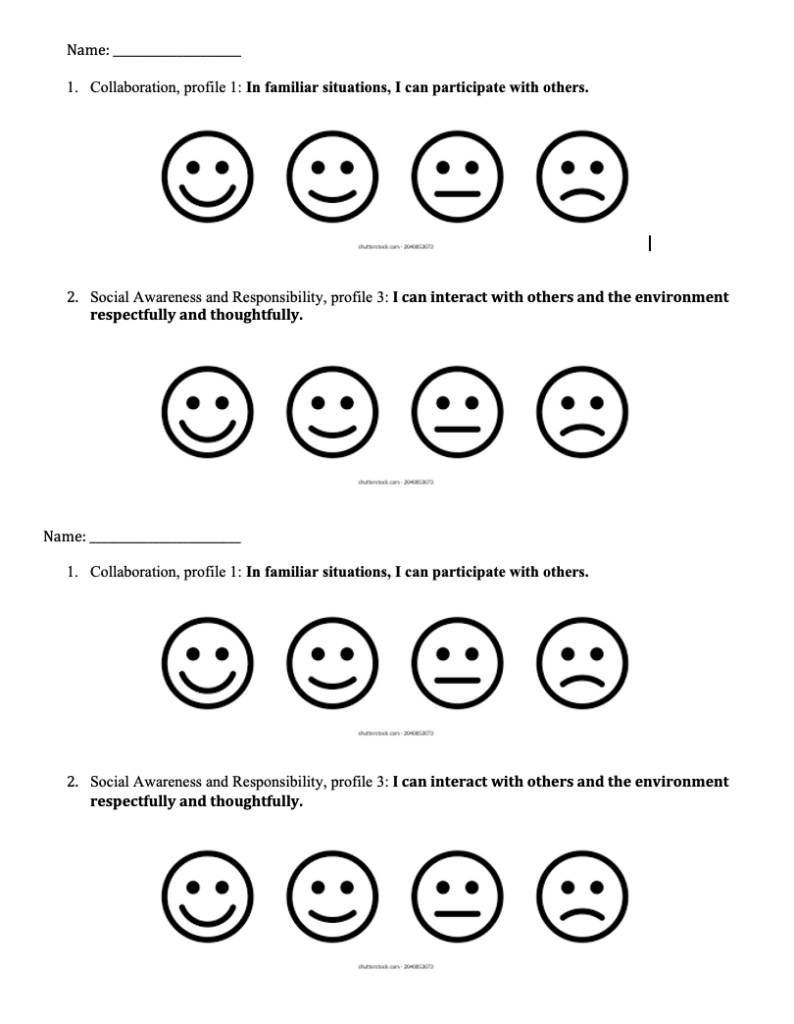
Lastly, below is an example of a self-assessment of the core competencies I created for an assignment in our assessment course (required to create a report card). This is just a made up example of one way I would create a self-assessment of the core competencies that is student-friendly with visuals:
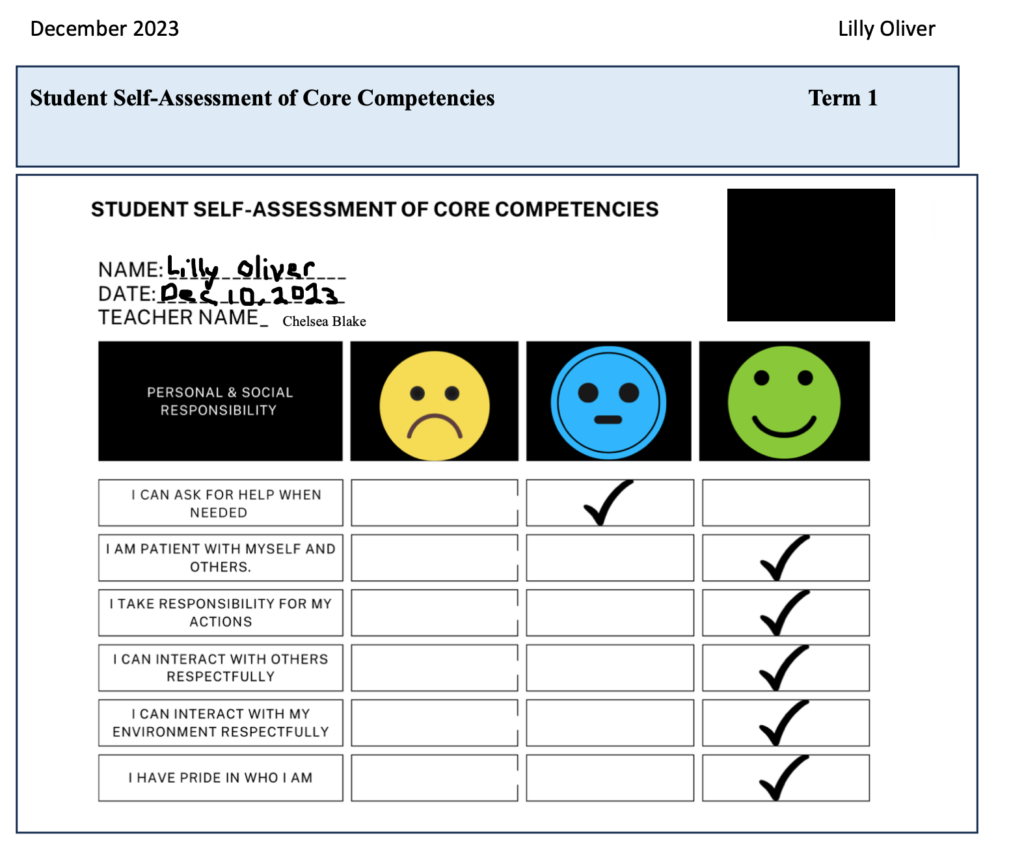
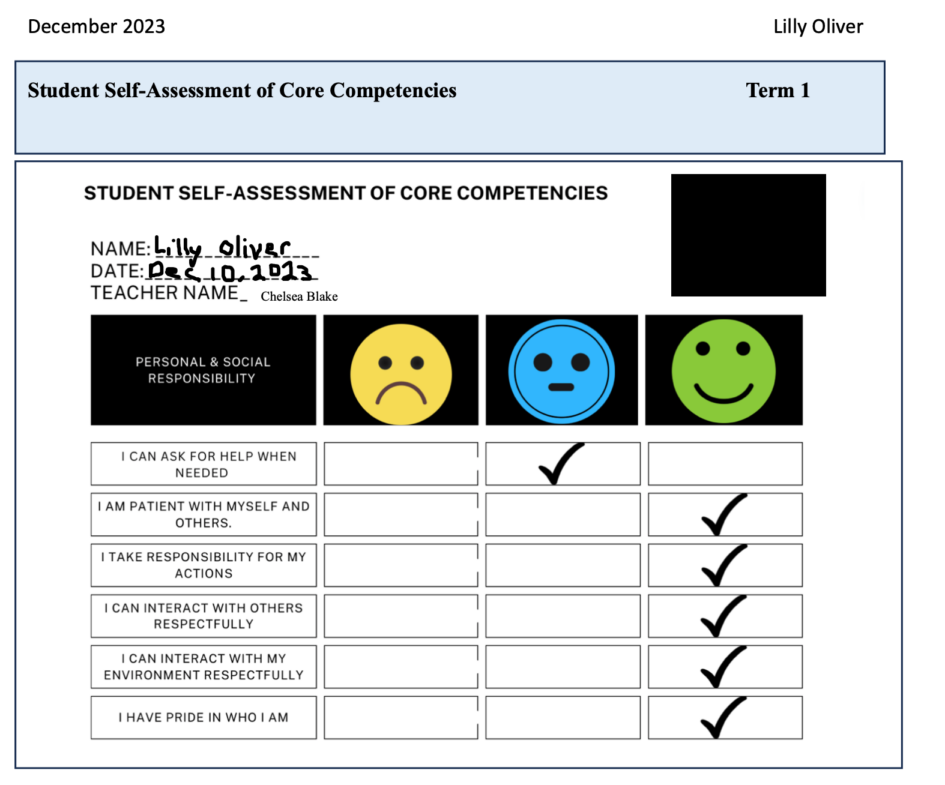
Leave a Reply
You must be logged in to post a comment.